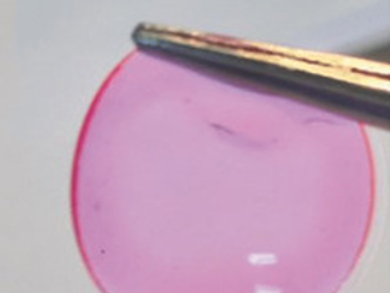Color blindness is a disorder that affects about 8 % of males in Northern Europe. Normal color vision is trichromatic: Three different photoreceptive cones in the eye are involved and each one is activated by a specific wavelength. The combination of different activation thresholds for the cones is processed in the brain and the corresponding color is perceived.
In the color-blind, one or more of the cones are missing due to a genetic defect. Hence, it is not possible to differentiate specific colors. However, color distinction can be improved by filtering out specific wavelengths to minimize the overlap between the remaining cones.
Abdel-Rahman Badawy and colleagues from the University of Birmingham, UK, have developed color-filtering contact lenses by submerging “normal” lenses for 30 seconds in a commercially available dye (Atto 565). The compound belongs to the rhodamine dyes and absorbs wavelengths of 545 to 575 nm. The team optimized the concentration of the dye used in the process and investigated its toxicity. They found that the dye is neither cytotoxic to human corneal fibroblasts nor to human corneal epithelial cells and, therefore, might be used for an improvement of color distinction in color-blind persons.
- Contact Lenses for Color Blindness,
Abdel-Rahman Badawy, Muhammad Umair Hassan, Mohamed Elsherif, Zubair Ahmed, Ali K. Yetisen, Haider Butt,
Adv. Healthcare Mater. 2018.
https://doi.org/10.1002/adhm.201800152



